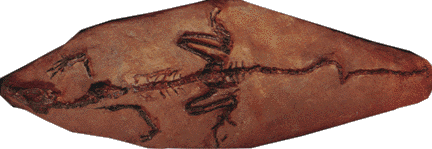
Mesenosaurus
romeri -Efremov, 1938- skeleton
Synapsida: Pelycosauria:
Varanopseidae
Locality: Mezen River, Arkhangelsk Region,
northern European Russia
Age: Late Permian, 260 million years ago
Meaning of
name: "reptile from Mezen"
Similarly
abundant was the small insectivorous pelycosaur Mesenosaurus of the family Varanopseidae,
whereas
the remains of the herbivorous pelycosaur Ennatosaurus
of the family Caseidae are comparatively more rare.
This small insectivorous reptile
was an eosuchian, the group that gave rise to the archosaurs and lizards,
the
core members of the sauropsid assemblage which was to replace the therapsid assemblage
in the Triassic.
Mesenosaurus was found in red clays deposited in an ancient lake
in what is now northern Russia.
Both these pelycosaur families were widely distributed
in the Early Permian of North America,
while in the Late Permian of East Europe
they were a relict component of the land assemblages.





